UPDATE 09/2018: Create a Bootable macOS Mojave Install Drive with DiskMaker X 8
UPDATE 09/2017: Create a Bootable macOS High Sierra Install Drive with DiskMaker X 7
UPDATE 09/2016: Create a Bootable macOS Sierra Install Drive with DiskMaker X
With OS X El Capitan, Apple has built on many of the changes that were brought on by Yosemite. And as with previous OS X versions dating back to OS X 10.7, El Capitan is only available for install via download from the App Store.
So if you previously relied on DVD installs, you won’t be able to do so with this version. Luckily, DiskMaker X helps fill the void by allowing you to make a bootable OS X 10.11 El Capitan USB install drive, making a task such as installing on several different machines easier.
Like the previous versions, DiskMaker X is free of charge (however, donations are accepted). All you need is an 8 GB (minimum) USB thumb drive, a USB, FireWire, or Thunderbolt drive or an SD-Card; the OS X 10.11 El Capitan Installer from the App Store (once the download is complete the installer file will appear in the Applications folder — do not move it); and the DiskMaker X installer. It should be noted that DiskMaker X erases the volume or the drive you chose, according to the options you chose. So don’t forget to backup your data first.
For more about OS X 10.11 and its new features, check out our handy El Capitan Compatibility and Transition Guide.
Here is our brief walkthrough for making an install drive:
1.) Launch the DiskMaker X installer and in the disk image window that appears, drag the application icon onto the Applications folder icon. The application will only take a second or two to be copied into the folder (it’s a small file). When finished, right-click in the disk image window and choose Eject Disk.
2.) Connect your USB thumb drive to your Mac, then launch the DiskMaker X application from your Applications folder.
3.) A small window will appear asking you to choose from three versions of OS X, in order to create the boot disk. Click the button that says “El Capitan (10.11)”.

4.) By default, DiskMaker X should find the OS X installer file you downloaded earlier. Click “Use this copy”.
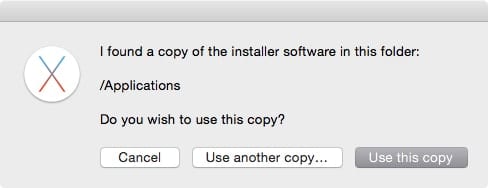
5.) Next you will be asked which kind of disk you want to use for your bootable installer. For this example, click the button that says “An 8 GB USB thumb drive”.
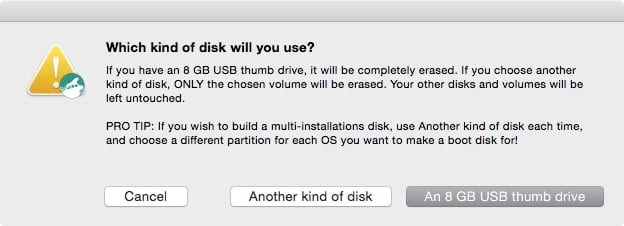
6.) DiskMaker X will find the available thumb drives connected to your Mac. Select the disk you want to use and click “Choose this disk”.
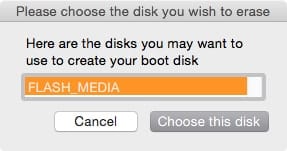
7.) DiskMaker X will warn you that you are about to erase the disk. If you are OK with this click “Erase then create the disk”. DiskMaker X will remind you that administrator privileges are required. Click Continue.
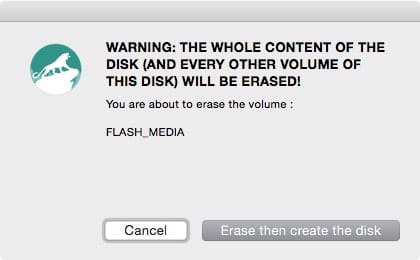
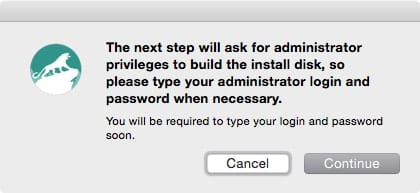
8.) Initially you will not see any windows for several seconds, then the administrator password dialog will appear. Type in your administrator password and click OK.
Next you will see a small window with progress information on it as the installer disk is created; the information will change as the process nears its end. Because the application sets up more than 6GB of installer data via a USB connection (most thumb drives use USB 2 which has a maximum data rate of ~ 50MB/s), this process will take a while. In our test, Step 8 took ~ 32 minutes.

9.) When the process is finished, a window should open displaying the contents of the new bootable drive. You can close this if you do not wish to begin the install process right away.
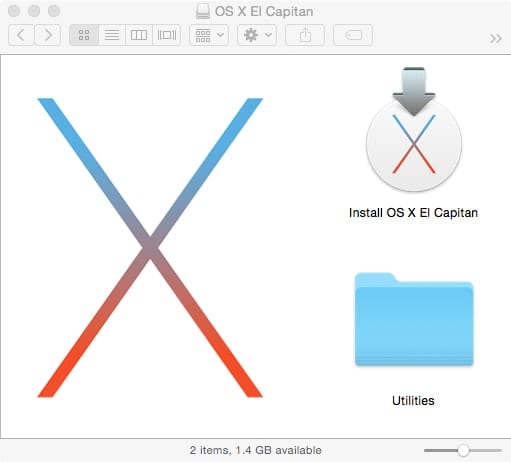
10.) Finally a dialog will pop up telling you that your boot disk is ready, giving you further options to quit, open the startup disk preferences so you can begin the OS X install process, and an option to make a donation.

(Within the Startup Disk preferences, once you set the new bootable installer disk to be the active boot drive, you can click the Restart… button and the OS X installation process will begin. From that point you can follow the standard OS X prompts as they appear.)
Learn more: Check out more OS X El Capitan coverage from the Rocket Yard here.
Note: OWC has no affiliation with this software and receives no benefit related to this support (other than a benefit we all share in the continued support of these applications). If you appreciate the function or functionality this software offers, we encourage you to support the authors.
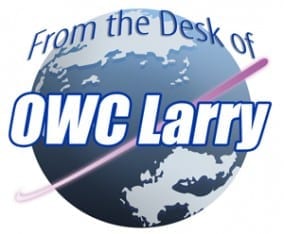

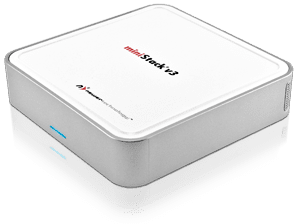






Using this Diskmaker to install the OSX installer for El Capitan which is beyond my late 2006 iMac’s limit to OSX Lion, will I be able to still install it?
Brilliant thank you very much for your help
Hi, the disk maker x that I dowloaded which is compatible with mojave doesn’t detect my usb, and I already erased my usb in disk utility in my Mac , what should I do?
Danke!
Hi, I’m doing this now and it keeps timing out. When I check the script ed it seems to have stopped at “debug mode = false” I can’t work out what’s not happening. Any ideas?
It worked up to number 8… diskmaker x prepare your disk but it give me that sudo phrase and at the end command not found??? What’s up with that
I still prefer to use the Disk Utility method. It always work flawlessly, and it’s really simply to use. You can avoid all the fuss of find the invisible files with the Terminal, by using a very handy and FREE GUI application named “ShowHiddenFiles” (gotoes.org/sales/ShowHiddenFilesMacOSX/How_To_Show_Hidden_Files.php). This nice application it’s a GUI implementation of the Terminal command to alter the visibility of files. I have tested “ShowHiddenFiles” up to El Capitan. I don’t know if it work well with Sierra and High Sierra, but I guess it must do.
I’m here to share a tip for those who create a OS X installer on a USB stick but can’t get it to boot: Most guides mention the Terminal Window method of creating a bootable copy of the Mac OS installer, and the older OS guides mention using Disk Utility to do the same task. What those methods omit, including Apple’s own support doc on this topic, is that the USB key must support “ownership”. (The reason why people find it easier to use Diskmaker X is because it’s doing that step for you.)
Apple’s officially supported method is to use the Terminal Window and a “create media” command line. Following such guides will allow for what should boot but that’s not always the case.
After much searching, I found out why even Apple’s own officially supported method is, at best, hit-or-miss: The “missing step” had to do with making the USB stick bootable (a permissions issue).
My non-booting USB El Capitan installer began to work after I right clicked it on the desktop, selected “Get Info”, unlocked the padlock icon on the lower right (enter admin pass) and then UNCHECKED the box for “ignore ownership”. If the USB key does not support this feature it may not work as a boot-up volume. If it does support it — but the default is checked — the OS X installer will complete successfully using the Terminal Window command line in these guides only for the USB stick to remain un-bootable. The solution is very straightforward but for some reason these guides almost universally leave out this step.
To give credit where credit is due, here is the source (a better version of Apple’s officially supported method because it includes the step on how to make a USB stick bootable, which may not be by default the case):
https://www.lifewire.com/create-emergency-os-x-boot-device-2260173
After installing EL CAPITAN, I can no longer make readable USB on external devices (in my car, cdj pioneer 400, etc…)
I have formatted it to NTFS, Mac OS Journaled, ExFAT but it does not work.
I read it only on Windows and Mac.
Create a bootable installer for macOS
https://support.apple.com/en-ca/HT201372
I’ve tried now http://macdaddy.io/install-disk-creator/ and it worked at the first trial.
I’ve tried with Diskmaker X v6.0 rc2 and three different sticks USB 2.0, Usb 3.0, different sizes but everytime it would end in the error message:
—–
The installation medium could not be created due to an error. Error: An error has occurred: -10006. “Finder” has received an error: “disk” Install OS X El Capitan “” can not be set as “” DMX_Workdisk “”.
Unfortunately I also couldn’t find a hint to get over this error. I appreciated a solution posting very much!
Completed all steps but when I go to startup disk preferences the only disk that shows up is the normal Macintosh HD disk. Not sure what to do.
Hi Guys,
I’ve noticed this thread has dragged on and have 2 suggestions.
1) Contact the program’s author. He’s a really nice French guy (I think) and seems to be willing to offer support. I donated $5 for the donation ware, but I’m sure that’s not a barrier to him supporting you. You may want to make sure it works for you, BEFORE donating. ;-)
2) If that doesn’t work, use some built in Terminal commands. MacWorld has an easily searchable article on the issue and the Terminal commands are fast and powerful. I’ll try and put the link here, but if it get’s yanked, just Google it.
When either of these approaches produce a bootable image, it will occur in just a few minutes if you’re on an SSD. And if you’re not on an SSD, you need to reevaluate your skill set. ;-)
Hope this helps.
Cheers.
If you see .. “This copy of the Install OS X El Capitan application can’t be verified. It may have been corrupted or tampered with during downloading” error.. You need to set your date using the CLI shell ‘date’ command.
i have Same problem . How to over come for this error…?
the “prepares your disk….please wait!” mssg has been up for over 30mins now, should I be worried? Early 2008 with Yosemite, copying to a 16GB USB formatted properly, just taking forever, should I worry? Please reply asap thx
Same problem
ff
thanks a lot!!!
Gracias ox x 11
I was able to create a bootable OS X El Capitan using Diskmaster X. At the point to format the new regular hard disk drive, at the drop down menu it gives an error message that reads ‘This Disk don’t Use the GUID Partition Table scheme. Use disk utility to change the partition scheme. Select the disk. Choose the partition tab, select the and then click options”. I did this instruction, however the only option at the Scheme drop down menu are GUID Patition, Bootmaster record, and Apple Partition Map. There is no Volume option. I tried all three option but it still gives me the same error message as described. Please advise. Thanks.
Got to step 8 but it says command not found. how can i fix this issue or what did i do wrong?
i have this problem on step 8 too. HELP!!
I am having the same issue at step 8. I get the following message below the DiskMaker X prepares disk… please wait!
sudo: /Applications/DiskMaker X 5.app//Contents/Resources/createinstallmedia:
command not found
Help!
I am trying to make the boot disk and after step 6). Close the disk, I keep getting this message;
The command exited with a non-zero status. (1)
Any help with this would be appreciated.
I now have a working El Capitan Boot Disk. Thank you, because I have 10 iMacs to go and that old 8GB flash drive was useless until now!
Glad to help!
I have the latest version of El Capitan installed. I keep getting the following message when trying to start DiskMaker X:
“No Installer application could be found. Click on Select an OS X Installation App and choose the OS X Installer application.”
I select the El Capitan download and get:
“This file can’t be used to create an OS X Installation disk.”
If you copied this file (rather than downloaded it) then the wrong file name or location may be incorrect. Disk maker X 5 won’t recognise it.
1) make sure the file is named “OS X El Capitan.app”
2) the file should be located in the Applications folder.
I could then proceed with DiskMaker X
I’m getting a “The disk could not be created because of an error: an error occured: -10810. An error of type – 10810 has occured.
So I can’t create a disk. I’m using a 16 gig flash drive. any help is appreciated.
Same -10810 error here ;-/
Same -10810 error
Is there a solution?
I have a MacBook Air, June 2012 currently running Mavericks. The El Capitan installer file came down to my Applications folder without problem, but multiple repeat attempts to create a bootable USB (16gb) drive using Diskmaker X 5 has failed. The program appears to go through all the steps, but finally the USB drive is never findable as a bootable drive.
I have the same problem
I am trying to erase the hard drive of my Mac Retina but the security system does not allow me to open disk image: 2this is an app downloaded from a non identifier developer. It does not allow me to add an exception
Evenmore, the computer does not open after a reboot if any key is pressed.
I am crazy. It seems like a virus is trying to prevent its dead.
it seems you locked your computer from accessing downloads from the unknown sources go to system preferences and then security and privacy and unlock it u will be able to fix it
This is the best tool I have ever used to create a bootable device. Awesome guys..!!
It worked perfectly. I used this tutorial to create a bootable USB to install El Capitan in a new external 1TB SSD Disk while keeping the original SSD disk as an internal disk.
Everything worked as expected.
Howdy !
Im an experienced Windows and OS X users and created numerous boot drives for both systems. 2nd attempt to try create bootable usb of El Capitan, and still no luck, seems to be stuck on the .Copying installer files to disk… message .
My macbook pro 13″ 2013 model is in great condition and just wish to do a fresh clean install. 1st attempt had been ongoing for just under 2 hours so i cancelled and changed usb drive to a newer faster usb. 2nd attempt is just at the hour mark now and appears to not be making much progress. Any suggestions ???
Didn’t work. Terminal reported command not found.
I’m a user not a teccy, so there was a degree of nervousness during the process. El Capitan downloaded but started to launch automatically, but my (early 2008) iMac froze. Left overnight – no change – so restarted and followed instructions for Diskmaker, but first time through Diskmaker didn’t like the new external SSD (soon to be my new internal HDD replacement). Second time through all ok. El C. now on the Samsung 850 SSD. So thank you guys. Still some ways to go but I’m getting there :))
I followed the directions but the USB Flash drive is not bootable. I did it 3 times and all ttys result in the Flash drive not be bootable. It copies everything over but the device simply is not bootable. It doesn’t show up in Startup Disk or when I hold the Option Key during boot up.
You may need to perform an extra step to make the USB stick bootable. Mount your non-booting flash drive to the desktop. Do a “get info” (depending on type of mouse you might be able to right-click it). When the box comes up look on the bottom right. Unlock the padlock (this requires your admin password). Now look on the bottom left. Uncheck the box that says “ignore ownership” (if you do not see this box you may have a USB flash drive that does not support “ownership” settings and so you will need to obtain one). Now click the padlock closed to save the changes. Reboot holding the option key. If the Mac OS X installer isn’t one of the boot options, zap the PRAM and try again.
If it still doesn’t work, verify that you have created the OS X installer in the same — or as recent of a version — of OS X as you intend to create on the USB flash drive. (Also bear in mind that older Mac OS X has a different method of making a USB flash drive bootable involving the use of Disk Utility rather than the Terminal Window “create media” command line that is used for newer incarnations for Mac OS X.)
I went for a whopping TWO YEARS without managing to figure out how to make a USB boot, even though by all appearances I had followed directions like this successfully (all the files were there). Then I stumbled across one lone how-to guide that mentioned the issue of USB flash drive ownership (must be a supported feature). The default setting on my USB flash drive was to disable the USB stick from booting up. If my experience is any indication a lot of people have run into this issue and because Apple’s own support docs, even, don’t mention this they end up going out and buying somebody else’s bootable Flash drive on Amazon or using Diskmaker X as a workaround for their own failed attempts. This “missing step” may be what is needed to make the USB stick bootable.
I did everything as instructed, HD is now locked and I cannot access it for installation, how can that be?
Hello Egil,
Sorry to hear about the trouble you’re having. You may want to check the DiskMaker X FAQ to see if any of the error messages or other behaviors detailed there are relevant to your setup.
http://diskmakerx.com/faq/
If you are still not able to find a solution, and the Mac or drive in question was purchased at Macsales.com, please contact our technical support team and we will do our best to assist you.
http://eshop.macsales.com/Service/
Might I suggest a way to add a package (or packages) to the install process if possible, such as the 10.11.1 update? I know it used to be possible to modify the installer script to add packages.
This could be a helpful option.
Thank you!
thank you
I’ve use DiskMaker X and successfully installed El Capitan on my iMac 12.2 and MacBook Pro 8.2. Both computers seem to work OK. However, on the iMac that I used to download El Capitan and made the USB Thumb Drive El Capitan Installer, I have been getting messages: “USB Devices Disabled Unplug the device using too much power to re-enable USB devices.” I did unplug all USB devices restarted the IMac, but the messages keep popping up. Seems this disabled all my USB slots except for the Apple Extended Keyboard. What can I do?
Hello Brian,
We are sorry to hear about this problematic iMac after the download. We recommend running a PRAM Reset and a SMC Reset.
If you are still getting the same error after the reset, please feel free to contact our Technical Support Team!
Is there any advantage of using DiskMaker X instead of just the Mac OS X installer to create a bootable disk?
It’s noticeably faster, easier and doesn’t require you to log in to the AppStore.
The OS X installer is, as per its name, just an installer, so it does not create a bootable disk that you could carry on and install on another Mac.
To figure the advantages of using DiskMaker out, just read the two first periods of this article.
“The OS X installer is, as per its name, just an installer, so it does not create a bootable disk that you could carry on and install on another Mac”.
In my experience over may years, the Mac OS X installer creates a bootable disk.
In my experience over many years, the OS X installer does create a bootable disk.
This program is AWESOME!!!! I even donated I was so thrilled. The best part (for us, where we need these every day in our shop) is that it bypassed the dumb AppStore login (which is patently ridiculous for a free program like an OS upgrade!). Saves us TONS of time and the Yosemite and El Cap installers really couldn’t have taken more that 60-90 seconds to create! UNBELIEVABLE! Love it!
Hi Mick.
It’s great to hear DiskMaker X has been so useful to your business. Thanks for sharing your feedback.
Does it also create or maintain the Recovery Disk?
Hi Carol,
Thanks for the question.
The short answer is yes, the thumb drive contains the standard OS X installer setup, which includes the ability to create recovery partitions on the target disk. This means you should end up with both a 10.11 boot volume and a 10.11 recovery partition.